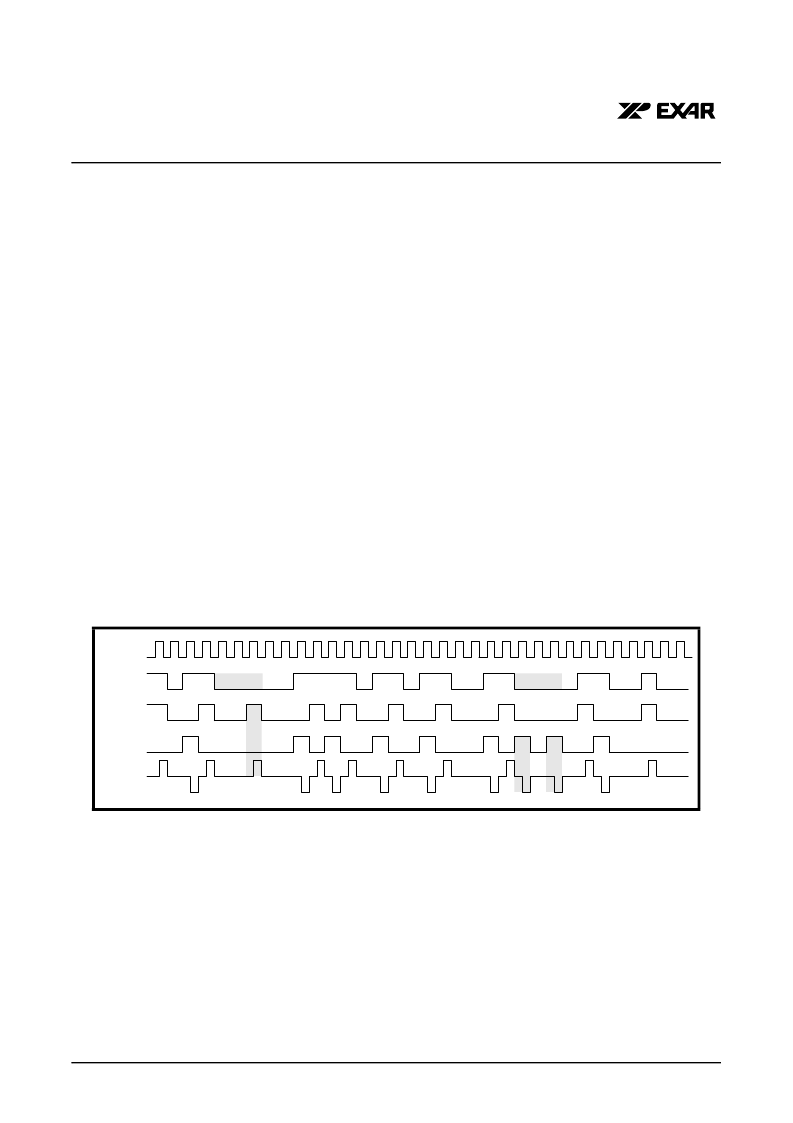- 您現(xiàn)在的位置:買賣IC網(wǎng) > PDF目錄376461 > XRT73L04AIV (EXAR CORP) 4 CHANNEL DS3/E3/STS-1 LINE INTERFACE UNIT PDF資料下載
參數(shù)資料
| 型號(hào): | XRT73L04AIV |
| 廠商: | EXAR CORP |
| 元件分類: | 數(shù)字傳輸電路 |
| 英文描述: | 4 CHANNEL DS3/E3/STS-1 LINE INTERFACE UNIT |
| 中文描述: | DATACOM, PCM TRANSCEIVER, PQFP144 |
| 封裝: | 20 X 20 MM, 1.40 MM HEIGHT, HEAT SINK, TQFP-144 |
| 文件頁(yè)數(shù): | 34/65頁(yè) |
| 文件大小: | 366K |
| 代理商: | XRT73L04AIV |
第1頁(yè)第2頁(yè)第3頁(yè)第4頁(yè)第5頁(yè)第6頁(yè)第7頁(yè)第8頁(yè)第9頁(yè)第10頁(yè)第11頁(yè)第12頁(yè)第13頁(yè)第14頁(yè)第15頁(yè)第16頁(yè)第17頁(yè)第18頁(yè)第19頁(yè)第20頁(yè)第21頁(yè)第22頁(yè)第23頁(yè)第24頁(yè)第25頁(yè)第26頁(yè)第27頁(yè)第28頁(yè)第29頁(yè)第30頁(yè)第31頁(yè)第32頁(yè)第33頁(yè)當(dāng)前第34頁(yè)第35頁(yè)第36頁(yè)第37頁(yè)第38頁(yè)第39頁(yè)第40頁(yè)第41頁(yè)第42頁(yè)第43頁(yè)第44頁(yè)第45頁(yè)第46頁(yè)第47頁(yè)第48頁(yè)第49頁(yè)第50頁(yè)第51頁(yè)第52頁(yè)第53頁(yè)第54頁(yè)第55頁(yè)第56頁(yè)第57頁(yè)第58頁(yè)第59頁(yè)第60頁(yè)第61頁(yè)第62頁(yè)第63頁(yè)第64頁(yè)第65頁(yè)

XRT73L04A
4 CHANNEL DS3/E3/STS-1 LINE INTERFACE UNIT
REV. 2.0.3
30
meet the applicable pulse template requirements.
The widths of these output pulses are defined by the
width of the half-period pulses within the TxClk_(n)
signal.
However, if the widths of the pulses within the
TxClk_(n) clock signal are allowed to vary significant-
ly, this could jeopardize the chip’s ability to generate
Transmit Output pulses of the appropriate width and
thereby not meet the Pulse Template requirement
specification. Consequently, the chip’s ability to gen-
erate compliant pulses could depend upon the duty
cycle of the clock signal applied to the TxClk_(n) input
pin.
The Transmit Clock Duty Cycle Adjust Circuitry ac-
cepts clock pulses via the TxClk_(n) input pin at duty
cycles ranging from 30% to 70% and converts them
to a 50% duty cycle.
2.3
T
HE
HDB3/B3ZS E
NCODER
B
LOCK
The purpose of the HDB3/B3ZS Encoder Block is to
aid in the Clock Recovery process at the Remote Ter-
minal Equipment by ensuring an upper limit on the
number of consecutive zeros that can exist within the
line signal.
2.3.1
B3ZS Encoding
If the XRT73L04A has been configured to operate in
the DS3 or SONET STS-1 Modes, then the HDB3/
B3ZS Encoder blocks operate in the B3ZS Mode.
When the Encoder is operating in this mode, it pars-
es through and searches the Transmit Binary Data
Stream from the Transmit Logic Block for the occur-
rence of three (3) consecutive zeros (e.g., "000"). If
the B3ZS Encoder finds an occurrence of three con-
secutive zeros, then it substitutes these three "0’s",
with either a "00V" or a "B0V" pattern.
Where:
"B" represents a Bipolar pulse that is compliant with
the Alternating Polarity requirements of the AMI (Al-
ternate Mark Inversion) line code; and
"V" represents a Bipolar Violation (e.g., a bipolar
pulse that violates the Alternating Polarity require-
ments of the AMI line code).
The B3ZS Encoder decides whether to substitute
with either the “00V" or the "B0V" pattern in order to
insure that an odd number of bipolar pulses exist be-
tween any two consecutive violation pulses.
Figure 17 illustrates the B3ZS Encoder at work with
two separate strings of three (or more) consecutive
zeros.
2.3.2
If the XRT73L04A is configured to operate in the E3
Mode, then the HDB3/B3ZS Encoder blocks operate
in the HDB3 Mode. When the Encoder is operating in
this mode, it parses through and searches the Trans-
mit Data Stream from the Transmit Logic Block for the
occurrence of four (4) consecutive zeros (e.g.,
"0000"). If the HDB3 Encoder finds an occurrence of
four consecutive zeros, then it substitutes these four
HDB3 Encoding
"0’s", with either a "000V" or a "B00V" pattern. The
HDB3 Encoder decides whether to substitute with ei-
ther the "000V" or the "B00V" pattern in order to in-
sure that an odd number of bipolar pulses exist be-
tween any two consecutive violation pulses.
Figure 18 illustrates the HDB3 Encoder at work with
two separate strings of four (or more) consecutive ze-
ros.
F
IGURE
17. A
N
E
XAMPLE
OF
B3ZS E
NCODING
TClk
TPOS
SR data
Encoded
PDATA
Encoded
NDATA
1
0
0
1
0
1
0
1
0
0
0
0
0
0
0
0
0
0
0
0
0
0
0
0
1
1
0
1
0
1
1
1
0
0
0
1
1
0
0
0
1
0
1
0
0
0
0
0
0
0
0
0
0
1
1
1
1
1
0
0
0
0
0
0
0
0
0
0
1
0
0
0
0
0
1
0
1
0
1
0
1
0
1
0
1
0
1
0
1
1
1
0
1
0
1
0
1
0
1
0
1
Line signal
B
V
0
V
0
0
0
相關(guān)PDF資料 |
PDF描述 |
|---|---|
| XRT73L04B | 4 CHANNEL DS3/E3/STS-1 LINE INTERFACE UNIT |
| XRT73L04BIV | 4 CHANNEL DS3/E3/STS-1 LINE INTERFACE UNIT |
| XRT73L04 | 4 Channel E3/DS3/STS-1 Line Interface Unit(4通道 E3/DS3/STS-1線接口單元) |
| XRT73L06 | SIX CHANNEL E3/DS3/STS-1 LINE INTERFACE UNIT |
| XRT73L06IB | SIX CHANNEL E3/DS3/STS-1 LINE INTERFACE UNIT |
相關(guān)代理商/技術(shù)參數(shù) |
參數(shù)描述 |
|---|---|
| XRT73L04B | 制造商:EXAR 制造商全稱:EXAR 功能描述:4 CHANNEL DS3/E3/STS-1 LINE INTERFACE UNIT |
| XRT73L04BES | 功能描述:網(wǎng)絡(luò)控制器與處理器 IC RoHS:否 制造商:Micrel 產(chǎn)品:Controller Area Network (CAN) 收發(fā)器數(shù)量: 數(shù)據(jù)速率: 電源電流(最大值):595 mA 最大工作溫度:+ 85 C 安裝風(fēng)格:SMD/SMT 封裝 / 箱體:PBGA-400 封裝:Tray |
| XRT73L04BIV | 功能描述:外圍驅(qū)動(dòng)器與原件 - PCI RoHS:否 制造商:PLX Technology 工作電源電壓: 最大工作溫度: 安裝風(fēng)格:SMD/SMT 封裝 / 箱體:FCBGA-1156 封裝:Tray |
| XRT73L04BIV-F | 功能描述:外圍驅(qū)動(dòng)器與原件 - PCI RoHS:否 制造商:PLX Technology 工作電源電壓: 最大工作溫度: 安裝風(fēng)格:SMD/SMT 封裝 / 箱體:FCBGA-1156 封裝:Tray |
| XRT73L06 | 制造商:EXAR 制造商全稱:EXAR 功能描述:SIX CHANNEL E3/DS3/STS-1 LINE INTERFACE UNIT |
發(fā)布緊急采購(gòu),3分鐘左右您將得到回復(fù)。